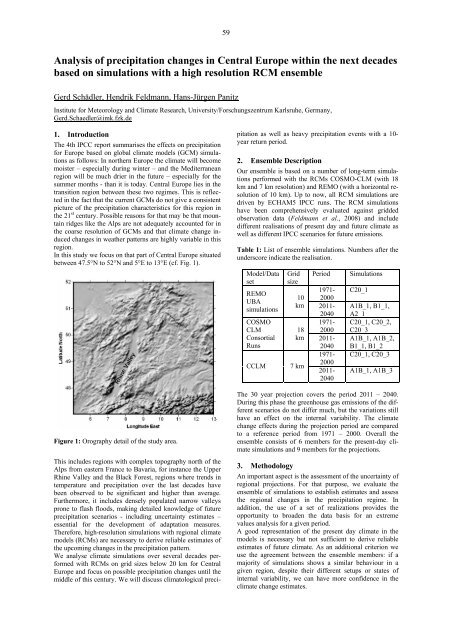Low (web) Quality - BALTEX
Low (web) Quality - BALTEX
Low (web) Quality - BALTEX
You also want an ePaper? Increase the reach of your titles
YUMPU automatically turns print PDFs into web optimized ePapers that Google loves.
59<br />
Analysis of precipitation changes in Central Europe within the next decades<br />
based on simulations with a high resolution RCM ensemble<br />
Gerd Schädler, Hendrik Feldmann, Hans-Jürgen Panitz<br />
Institute for Meteorology and Climate Research, University/Forschungszentrum Karlsruhe, Germany,<br />
Gerd.Schaedler@imk.fzk.de<br />
1. Introduction<br />
The 4th IPCC report summarises the effects on precipitation<br />
for Europe based on global climate models (GCM) simulations<br />
as follows: In northern Europe the climate will become<br />
moister – especially during winter – and the Mediterranean<br />
region will be much drier in the future – especially for the<br />
summer months - than it is today. Central Europe lies in the<br />
transition region between these two regimes. This is reflected<br />
in the fact that the current GCMs do not give a consistent<br />
picture of the precipitation characteristics for this region in<br />
the 21 st century. Possible reasons for that may be that mountain<br />
ridges like the Alps are not adequately accounted for in<br />
the coarse resolution of GCMs and that climate change induced<br />
changes in weather patterns are highly variable in this<br />
region.<br />
In this study we focus on that part of Central Europe situated<br />
between 47.5°N to 52°N and 5°E to 13°E (cf. Fig. 1).<br />
Figure 1: Orography detail of the study area.<br />
This includes regions with complex topography north of the<br />
Alps from eastern France to Bavaria, for instance the Upper<br />
Rhine Valley and the Black Forest, regions where trends in<br />
temperature and precipitation over the last decades have<br />
been observed to be significant and higher than average.<br />
Furthermore, it includes densely populated narrow valleys<br />
prone to flash floods, making detailed knowledge of future<br />
precipitation scenarios - including uncertainty estimates –<br />
essential for the development of adaptation measures.<br />
Therefore, high-resolution simulations with regional climate<br />
models (RCMs) are necessary to derive reliable estimates of<br />
the upcoming changes in the precipitation pattern.<br />
We analyse climate simulations over several decades performed<br />
with RCMs on grid sizes below 20 km for Central<br />
Europe and focus on possible precipitation changes until the<br />
middle of this century. We will discuss climatological precipitation<br />
as well as heavy precipitation events with a 10-<br />
year return period.<br />
2. Ensemble Description<br />
Our ensemble is based on a number of long-term simulations<br />
performed with the RCMs COSMO-CLM (with 18<br />
km and 7 km resolution) and REMO (with a horizontal resolution<br />
of 10 km). Up to now, all RCM simulations are<br />
driven by ECHAM5 IPCC runs. The RCM simulations<br />
have been comprehensively evaluated against gridded<br />
observation data (Feldmann et al., 2008) and include<br />
different realisations of present day and future climate as<br />
well as different IPCC scenarios for future emissions.<br />
Table 1: List of ensemble simulations. Numbers after the<br />
underscore indicate the realisation.<br />
Model/Data<br />
set<br />
REMO<br />
UBA<br />
simulations<br />
COSMO<br />
CLM<br />
Consortial<br />
Runs<br />
CCLM<br />
Grid Period<br />
size<br />
1971-<br />
10 2000<br />
km 2011-<br />
2040<br />
1971-<br />
18 2000<br />
km 2011-<br />
2040<br />
1971-<br />
2000<br />
7 km<br />
2011-<br />
2040<br />
Simulations<br />
C20_1<br />
A1B_1, B1_1,<br />
A2_1<br />
C20_1, C20_2,<br />
C20_3<br />
A1B_1, A1B_2,<br />
B1_1, B1_2<br />
C20_1, C20_3<br />
A1B_1, A1B_3<br />
The 30 year projection covers the period 2011 – 2040.<br />
During this phase the greenhouse gas emissions of the different<br />
scenarios do not differ much, but the variations still<br />
have an effect on the internal variability. The climate<br />
change effects during the projection period are compared<br />
to a reference period from 1971 – 2000. Overall the<br />
ensemble consists of 6 members for the present-day climate<br />
simulations and 9 members for the projections.<br />
3. Methodology<br />
An important aspect is the assessment of the uncertainty of<br />
regional projections. For that purpose, we evaluate the<br />
ensemble of simulations to establish estimates and assess<br />
the regional changes in the precipitation regime. In<br />
addition, the use of a set of realizations provides the<br />
opportunity to broaden the data basis for an extreme<br />
values analysis for a given period.<br />
A good representation of the present day climate in the<br />
models is necessary but not sufficient to derive reliable<br />
estimates of future climate. As an additional criterion we<br />
use the agreement between the ensemble members: if a<br />
majority of simulations shows a similar behaviour in a<br />
given region, despite their different setups or states of<br />
internal variability, we can have more confidence in the<br />
climate change estimates.













